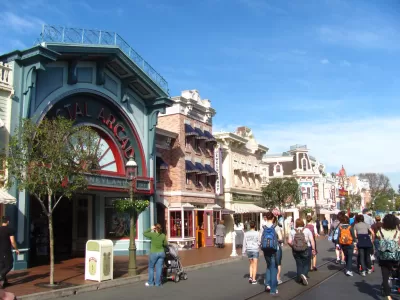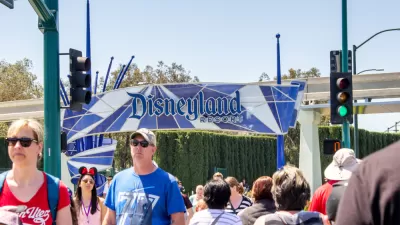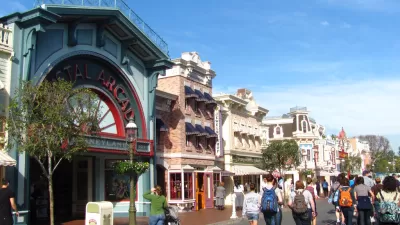The conference of the California chapter of the American Planning Association took place across the street from Disneyland this week. What Disney does for fictional landscapes, planners must do for real landscapes.

“On the one hand, the there's a shocking contrast between the lifelessness of Harbor Bl. and the intrigue of Tomorrow, Fantasy, Adventure (and, of course, California Adventure, which you apparently visit if you don't like the real California but also don't want to leave California).”
“On the other hand, that contrast is likely a feature, not a bug. Disneyland came about precisely at the peak of and, I would argue, because of mid-20th century suburbanization. As the country was becoming deliberately dull and homogenous in the late 1950s, a place of excitement, escape, and, indeed, ersatz urbanism became more marketable. Disneyland promoted suburbanization in order to offer an antidote to suburbanization. The uglier [Anaheim] is, and the less pleasant that walk is, the more exciting those other -lands become.”
“Disneyland is nicer than the real world. People are willing to pay for nice, even for only a few hours. That's because, for much of recent history, in the vast majority of places, the imagination and talent has been privatized, funded, and promoted, and the public realm has, in too many cases, been neglected, starved, and vilified. The public realm doesn't get nearly the sort of attention and investment as even a few dozen acres of private realm.”
FULL STORY: APA Conference: When Planners Wish Upon a Star

Maui's Vacation Rental Debate Turns Ugly
Verbal attacks, misinformation campaigns and fistfights plague a high-stakes debate to convert thousands of vacation rentals into long-term housing.

Planetizen Federal Action Tracker
A weekly monitor of how Trump’s orders and actions are impacting planners and planning in America.

Chicago’s Ghost Rails
Just beneath the surface of the modern city lie the remnants of its expansive early 20th-century streetcar system.

Bend, Oregon Zoning Reforms Prioritize Small-Scale Housing
The city altered its zoning code to allow multi-family housing and eliminated parking mandates citywide.

Amtrak Cutting Jobs, Funding to High-Speed Rail
The agency plans to cut 10 percent of its workforce and has confirmed it will not fund new high-speed rail projects.

LA Denies Basic Services to Unhoused Residents
The city has repeatedly failed to respond to requests for trash pickup at encampment sites, and eliminated a program that provided mobile showers and toilets.
Urban Design for Planners 1: Software Tools
This six-course series explores essential urban design concepts using open source software and equips planners with the tools they need to participate fully in the urban design process.
Planning for Universal Design
Learn the tools for implementing Universal Design in planning regulations.
planning NEXT
Appalachian Highlands Housing Partners
Mpact (founded as Rail~Volution)
City of Camden Redevelopment Agency
City of Astoria
City of Portland
City of Laramie





























